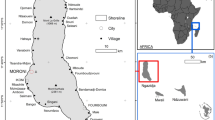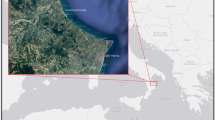Abstract
Coastal vulnerability assessments to climate change impacts have been conducted in the past. However, few if any account for the highly variable risk associated with tidal stage in macro-tidal environments. The purpose of this research was to develop a geomatics tool which interactively determines the biophysical vulnerability of a macro-tidal estuary in the Bay of Fundy to varying levels of storm surge and tide state. A conceptual framework was designed to illustrate the relative interrelationships between exposure conditions (surge height, tidal stage), biophysical state (freeboard, exposure, width of foreshore, intertidal slope, observed erodibility, shore protection) and morphological resilience condition. This conceptual framework was then used to develop a dynamic, custom Python programming script within ArcGIS 9.3 to calculate coastal vulnerability for user determined combinations of surge height and tide state. The analysis was conducted for four coastlines, backshore, upper foreshore, middle foreshore and lower foreshore, to reflect varying biophysical states with varying tide levels. The results of the tool were compared with known areas of concern (high erosion, dyke overtopping), as determined by historical records, local expert knowledge and GIS analysis of aerial photography. The number of known locations of concern is lower than that of the results produced by the tool. This is most likely due to the results being analyzed at extreme water levels, greater than higher high water large tide. However, this estimation of vulnerability may limit negative impacts of climate change by highlighting vulnerable areas prior to an event, allowing coastal managers and planners to install measures to reduce the vulnerability and enhance the adaptive capacity of local communities.














Similar content being viewed by others
References
Abuodha PAO, Woodroffe CD (2010) Assessing vulnerability to sea level rise using a coastal sensitivity index: a case study from Southeast Australia. J Coast Conserv Plan Manag 14:189–205
Atlantic Canadian Adaptation Solutions Association (2012) Increasing climate change adaptation capacity in Atlantic Canada. http://atlanticadaptation.ca/objectives. Accessed 20 March 2012
Boruff BJ, Emrich C, Cutter SL (2005) Erosion hazard vulnerability of US coastal counties. J Coast Res 21(5):932–942
Bryan B, Harvey N, Belperio T, Bourman B (2001) Distributed process modeling for regional assessment of coastal vulnerability to sea-level rise. Environ Model Assess 6:57–65
Capobianco M, DeVriend HJ, Nicholls RJ, Stive MJE (1999) Coastal area impact and vulnerability assessment: the point of view of a morphodynamic modeller. J Coast Res 15(3):701–716
Cooper JAG, McLaughlin S (1998) Contemporary multidisciplinary approaches to coastal classification and environmental risk analysis. J Coast Res 14(2):512–524
Cutter SL (1996) Vulnerability to environmental hazards. Prog Hum Geogr 20(4):529–539
Davies JL (1980) Geographical variation in coastal development. Longman, London, UK
Davis RA, Fitzgerald DM (2004) Beaches and coasts. Blackwell Pub, Malden
Desplanque C, Mossman D (2004) Tides and their seminal impact on the geology, geography, history, and socio-economics of the Bay of Fundy, Eastern Canada. Atl Geol 40(1). doi:10.4138/729
Desplanque C, Mossman D (2001) Bay of Fundy tides. Geosci Can 25(1):1–11
Dolan AH, Walker IJ (2006) Understanding vulnerability of coastal communities to climate change related risks. J Coast Res SI 39:1316–1323
Fedra K, Feoli E (1998) GIS technology and spatial analysis in coastal management. EEZ Technol 3:171–179
Fonseca MS, Malhotra A (2010) WEMo (Wave Expose Model) for use in ecological forecasting. Applied Ecology and Restoration Research Branch NOAA, National Ocean Service. http://www.csc.noaa.gov/digitalcoast/tools/wemo/index.html. Accessed 21 March 2012
Garmendia E, Gamboa G, Franco J, Garmendia J, Liria P, Olazabal M (2010) Social multi-criteria evaluation as a decision support tool for integrated coastal zone management. Ocean Coast Manag 53:385–403
Gornitz VM, Daniels RC, White TW, Birdwell KR (1994) The development of a coastal risk assessment database: vulnerability to sea-level rise in the U.S. Southeast. J Coast Res 12:327–338
Government of Nova Scotia, Nova Scotia Environment (2009) Wetland conversation policy—Draft for consultation. http://www.gov.ns.ca/nse/wetland/conservation.policy.asp. Accessed on 21 January 2012
Greenberg DA, Blanchard W, Smith B, Barrow E (2012) Climate change, mean sea level and high tides in the Bay of Fundy. Atmosphere–ocean. doi:10.1080/07055900.2012.668670
Hart DE, Knight GA (2009) Geographic information system assessment of tsunami vulnerability on a dune coast. J Coast Res 25(1):131–141
Hinton AC (2000) Tidal changes and coastal hazards: past, present and future. Nat Hazard 21:173–184
Jackson CW Jr (2010) Basic user guide for the AMBUR package for R, version 1.0a. Unpublished. https://r-forge.r-project.org/projects/ambur/. Accessed 20 Jan 2012
Kelly PM, Adger WN (2000) Theory and practice in assessing vulnerability to climate change and facilitating adaptation. Clim Chang 47:325–352
Klein RJT, Nicholls RJ (1999) Assessment of coastal vulnerability to climate change. Ambio 28(2):182–187
Klein RJT, Smit MJ, Goosen H, Hulsbergen CH (1998) Resilience and vulnerability: coastal dynamics or Dutch dikes? Geogr J 164(3):259–268
Kosloski, A (2008) Planning for climate change and coastal zone management: land use vulnerability, hazard, and exposure in Halifax Harbour, Halifax Regional Municipality. Dalhousie University, Master of Planning. http://ccns.chebucto.org/Planning_CZM.pdf. Accessed 20 March 2012
Kumar TS, Mahendra RS, Nayak S, Radhakrishnan K, Sahu KC (2010) Coastal vulnerability assessment for Orissa State, East Coast of India. J Coast Res 26(3):523–534
Leonard LA, Reed DJ (2002) Hydrodynamics and sediment transport through tidal marsh canopies. J Coast Res SI 36:459–469
Malczewski J (1999) GIS and multicriteria decision analysis. John Wiley & Sons, New York
Masselink G, Short AD (1993) The effect of tide range on beach morphodynamics and morphology: a conceptual beach model. J Coast Res 9(3):785–800
McLaughlin S, McKenna J, Cooper JAG (2002) Socio-economic data in coastal vulnerability indices: constraints and opportunities. J Coast Res SI 36:487–497
Moller I (2003) The sea-defence role of intertidal habitats. In: Ledoux L (ed) Wetland valuation: state of the art and opportunities for further development. Proceedings of a workshop organised for the Environment Agency by Environmental Futures Ltd and CSERGE, University of East Anglia, Norwich, UK, pp 73–88
Moller I, Spencer T (2002) Wave dissipation over macro-tidal saltmarshes: effects of marsh edge typology and vegetation change. J Coast Res SI 36:506–521
Morton RA, Miller TL, Moore LJ (2004) National assessment of shoreline change: Part 1 historical shoreline change and associated coastal land loss along the U.S. Gulf of Mexico. U.S. Department of the Interior, U.S. Geological Survey Open-File Report 2004–1043. http://pubs.usgs.gov/of/2005/1401/. Accessed 20 March 2012
Moore LJ (2000) Shoreline mapping techniques. J Coast Res 16(1):111–124
O’Carroll S, Bérubé D, Forbes D, Hanson A, Jolicoeur S, Fréchette A (2006) Coastal erosion. In: Daigle R (ed) Impacts of sea-level rise and climate change on the coastal zone of Southeastern New Brunswick. New Brunswick Department of Environment, New Brunswick, pp 324–401
Owens EH (1994) Coastal zone classification system for the national sensitivity mapping program. Internal Report, Environment Canada. Cat. No.En 40-488/1995E, Dartmouth, N.S
Ozyurt G, Ergin A (2010) Improving coastal vulnerability assessments to sea-level rise: a new indicator based methodology for decision makers. J Coast Res 26(2):265–273
Pendleton EA, Thieler ER, Williams SJ (2010) Importance of coastal change variables in determining vulnerability to sea- and lake-level change. J Coast Res 26(1):176–183
Pendleton EA, Jeffress SW, Thieler ER (2004) Coastal vulnerability assessment of Assateague Island National Seashore (ASIS) to sea level rise. U.S. Geological Survey Open-File Report 2004–1020 Electronic Book
Rao Nageswara K, Subraelu P, Rao Venkateswara T, Hema Malini B, Ratheesh R, Bhattacharya S, Rajawat AS (2008) Sea-level rise and coastal vulnerability: an assessment of Andhra Pradesh coast, India through remote sensing and GIS. J Coast Conserv Plan Manag 12:195–207
Richards W, Daigle R (2011) Scenarios and guidance for adaptation to climate change and sea level rise—NS and PEI Municipalities. www.atlanticadapation.ca. Accessed 27 April 2012
Shaw J, Taylor RB, Solomon S, Christian HA, Forbes DL (1998) Potential impacts of global sea level rise on Canadian coasts. Can Geogr 42(4):365–379
Sherin AG, Fraser P, Solomon S, Forbes DL, Jenner KA, Hynes S, Lynds T, Gareau P (2003) A decade in the life of a coastal information system. Proceedings, Coast GIS 2003: 5th International Symposium on GIS and Computer Cartography for Coastal Zone Management, Genoa, Italy. http://www.gisig.it/coastgis/papers/sherin.htm. Accessed 30 March 2012
Sterr H, Klein R, Reese S (2000) Climate change and coastal zones: An overview of the state-of-the-art on regional and local vulnerability assessment. http://www.sterr.geographie.uni-kiel.de/downloads/ClimateChange.pdf. Accessed 20 March 2012
Thieler ER, Hammar-Klose ES (1999) National assessment of coastal vulnerability to future sea-level rise: preliminary results for the U.S. Atlantic Coast: U.S. Geological Survey. Open-File Report 99–593. http://woodshole.er.usgs.gov/project-pages/cvi/. Accessed 20 March 2011
Thumerer T, Jones AP, Brown D (2000) A GIS based coastal management system for climate change associated flood risk assessment on the east coast of England. Int J Geogr Inf Sci 14(3):265–281
van Proosdij D, Perrott B, Carroll C (2013) Development and application of a geotemporal atlas for climate change adaptation in Bay of Fundy dykelands. In: Conley, D.C., Masselink, G., Russell, P.E. and O’Hare, T.J. (eds.), Proceedings 12th International Coastal Symposium (Plymouth, England). J Coast Res Special Issue No. 65, pp. xxx–xxx, ISSN 0749–0208
van Proosdij D, Pietersma-Perrott B (2012) Shore zone characterization for climate change adaptation in the Bay of Fundy. Saint Mary’s University. http://atlanticadaptation.ca/. Accessed 18 March 2012
Vasseur L, Catto N, Burton D, Chouinard O, Davies J, DeBaie L, Duclos G, Duinker P, Forbes D, Hermanutz L, Jacobs J, Leger L, McKenzie K, Parlee K, Straatman J (2008) Atlantic Canada In: Lemmen DS, Warren FJ, Lacroix J, Bush E (eds) From impacts to adaptation: Canada in a changing climate 2007. Government of Canada, pp 119–170
Webster T, McGuigan K, MacDonald C (2011) Lidar processing and flood risk mapping for coastal areas in the district of Lunenburg, Town and District of Yarmouth, Amherst, County Cumberland, Wolfville and Windsor. Climate Change Directorate, Nova Scotia Department of the Environment. http://atlanticadaptation.ca/node/128. Accessed 7 March 2012
Wu SY, Yarnai B, Fisher A (2002) Vulnerability of coastal communities to sea level rise: a case study of Cape May County, New Jersey. Clim Res 22:25–270
Acknowledgments
We would like to thank Barbara Pietersma, GIS Project Manager, MP_SpARC, Saint Mary’s University, Greg Baker, Instrument Technician, MP_SpARC, Saint Mary’s University, Ken Carroll and Daryl Hingley, Nova Scotia Department of Agriculture, Don Forbes, Geological Survey of Canada (GSC), Philip Giles, Department of Geography, Saint Mary’s University, Devon Olivola Eulie, Department of Geological Sciences at East Carolina University. Funding for this project was provided by the Atlantic Climate Adaptation Solutions Association (ACASA) and Natural Resources Canada administered by Nova Scotia Environment Climate Change Secretariat.
Author information
Authors and Affiliations
Corresponding author
Rights and permissions
About this article
Cite this article
Tibbetts, J.R., van Proosdij, D. Development of a relative coastal vulnerability index in a macro-tidal environment for climate change adaptation. J Coast Conserv 17, 775–797 (2013). https://doi.org/10.1007/s11852-013-0277-9
Received:
Revised:
Accepted:
Published:
Issue Date:
DOI: https://doi.org/10.1007/s11852-013-0277-9




